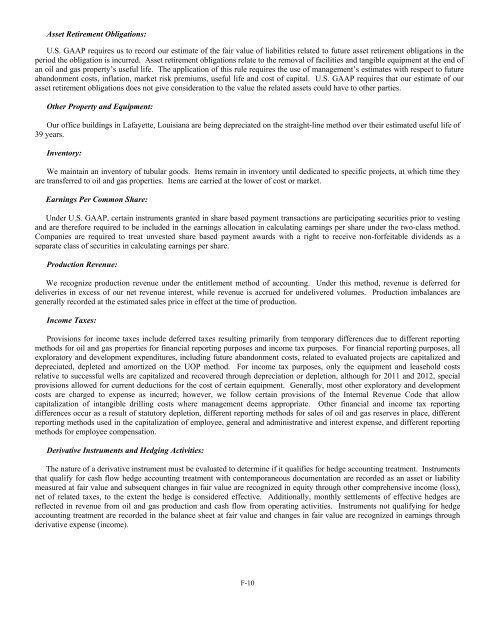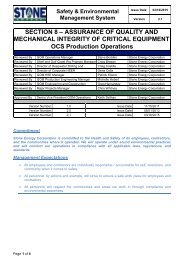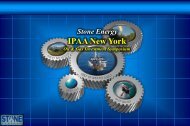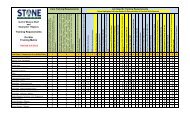2012 Annual Report - Stone Energy Corporation
2012 Annual Report - Stone Energy Corporation
2012 Annual Report - Stone Energy Corporation
You also want an ePaper? Increase the reach of your titles
YUMPU automatically turns print PDFs into web optimized ePapers that Google loves.
Asset Retirement Obligations:U.S. GAAP requires us to record our estimate of the fair value of liabilities related to future asset retirement obligations in theperiod the obligation is incurred. Asset retirement obligations relate to the removal of facilities and tangible equipment at the end ofan oil and gas property’s useful life. The application of this rule requires the use of management’s estimates with respect to futureabandonment costs, inflation, market risk premiums, useful life and cost of capital. U.S. GAAP requires that our estimate of ourasset retirement obligations does not give consideration to the value the related assets could have to other parties.Other Property and Equipment:Our office buildings in Lafayette, Louisiana are being depreciated on the straight-line method over their estimated useful life of39 years.Inventory:We maintain an inventory of tubular goods. Items remain in inventory until dedicated to specific projects, at which time theyare transferred to oil and gas properties. Items are carried at the lower of cost or market.Earnings Per Common Share:Under U.S. GAAP, certain instruments granted in share based payment transactions are participating securities prior to vestingand are therefore required to be included in the earnings allocation in calculating earnings per share under the two-class method.Companies are required to treat unvested share based payment awards with a right to receive non-forfeitable dividends as aseparate class of securities in calculating earnings per share.Production Revenue:We recognize production revenue under the entitlement method of accounting. Under this method, revenue is deferred fordeliveries in excess of our net revenue interest, while revenue is accrued for undelivered volumes. Production imbalances aregenerally recorded at the estimated sales price in effect at the time of production.Income Taxes:Provisions for income taxes include deferred taxes resulting primarily from temporary differences due to different reportingmethods for oil and gas properties for financial reporting purposes and income tax purposes. For financial reporting purposes, allexploratory and development expenditures, including future abandonment costs, related to evaluated projects are capitalized anddepreciated, depleted and amortized on the UOP method. For income tax purposes, only the equipment and leasehold costsrelative to successful wells are capitalized and recovered through depreciation or depletion, although for 2011 and <strong>2012</strong>, specialprovisions allowed for current deductions for the cost of certain equipment. Generally, most other exploratory and developmentcosts are charged to expense as incurred; however, we follow certain provisions of the Internal Revenue Code that allowcapitalization of intangible drilling costs where management deems appropriate. Other financial and income tax reportingdifferences occur as a result of statutory depletion, different reporting methods for sales of oil and gas reserves in place, differentreporting methods used in the capitalization of employee, general and administrative and interest expense, and different reportingmethods for employee compensation.Derivative Instruments and Hedging Activities:The nature of a derivative instrument must be evaluated to determine if it qualifies for hedge accounting treatment. Instrumentsthat qualify for cash flow hedge accounting treatment with contemporaneous documentation are recorded as an asset or liabilitymeasured at fair value and subsequent changes in fair value are recognized in equity through other comprehensive income (loss),net of related taxes, to the extent the hedge is considered effective. Additionally, monthly settlements of effective hedges arereflected in revenue from oil and gas production and cash flow from operating activities. Instruments not qualifying for hedgeaccounting treatment are recorded in the balance sheet at fair value and changes in fair value are recognized in earnings throughderivative expense (income).F-10









